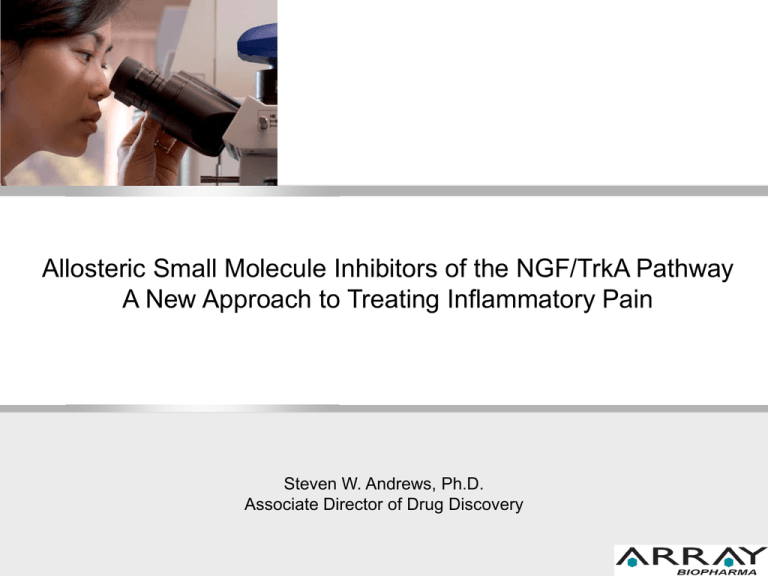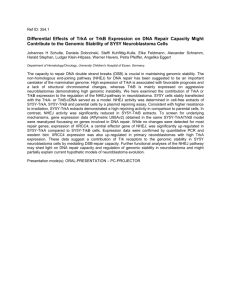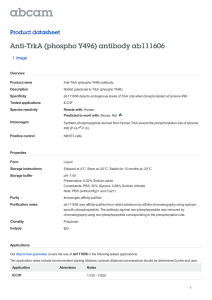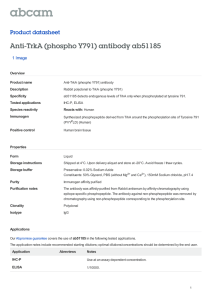Allosteric Small Molecule Inhibitors of the NGF/TrkA
advertisement

Allosteric Small Molecule Inhibitors of the NGF/TrkA Pathway A New Approach to Treating Inflammatory Pain Steven W. Andrews, Ph.D. Associate Director of Drug Discovery 1 Challenges Faced with Discovery of New Drugs in the Pain Space Translation of pre-clinical results to clinical outcome Efficacy Poor translation from animal models to man and vice versa Safety Mechanism specific toxicities are not always apparent until reaching the clinic Bar for safety for new pain drugs is very high Economic Considerations While existing SOC have deficiencies and liabilities, these treatments are quite cost effective and offer many convenient dosage forms Our approach: small molecule inhibitors for antibody validated pathways AR-797 P38 inhibitor – targeting NSAID resistant pain (Phase II) Trk inhibitors – targeting the NGF pathway (pre-clinical) 2 Tanezumab- anti-NGF Antibody has Validated Clinical Efficacy Lane et al. (2010) NEJM 363:1521 Katz et al. (2011) Pain 152:2248 Similarly impressive efficacy reported in Chronic Low Back Pain2 but concerns of joint findings in OA patients with chronic dosing, particularly with NSAIDs Key Question- is there an alternative and perhaps safer approach to inhibit this pathway 3 Neurotrophin / Trk Signaling Mediates Peripheral Pain Response Local release Peripheral Hypersensitization NGF TrkA Proinflammatory cell Central recruitment and degranulation Hypersensitization Neurotrophin Receptors- TrkA and B are critical signaling partners in the NGF pain cascade 4 Mechanisms for Inhibiting Neurotrophin / Trk Signaling Cascade Growth Factor Antibodies NGF BDNF NT-4 NT-3 C1 LRR1-3 C2 Ig1 Trk Receptor Antibodies Ig2 Trk kinase domain inhibitors CR1 CR2 CR3 CR4 ATP site 100% homology in ATP site Trk A TrkB TrkC Our ATP site inhibitors selectively inhibit the pan-Trk axis, but not other kinases 5 P75NTR Key Scientific Questions- Small Molecule Pan-Trk Kinase vs. anti-NGF Efficacy for Pain Relief? • Added efficacy from the TrkB component? • Differences related to mechanism of inhibition? • Differences related to duration of inhibition? – Long term vs intermittent target knockdown? Safety? • Differences related to mechanism of inhibition? • Differences related to duration of inhibition? – Long term vs intermittent target knockdown? • Safety concerns for added TrkB and TrkC inhibition? Our approach: in vivo evaluation with selective small molecule pan-Trk inhibitors – 6 Approach to Finding Highly Selective Trk Chemical Matter High Throughput Screen ARRAY diversity and kinase focused Trk potency Promising Kinase <50 compounds ~many compound hits in 2 novel chemical series in > 20 chemical series Selectivity and “drug-likeness” DMPK Pharmacology Toxicology Medicinal Chemistry Optimization >1500 designed compounds pan-Trk series (ATP site) 7 Trk X-ray Crystallography • Tuned for high kinase selectivity outside of Trk family • equipotent for TrkA, TrkB and TrkC ~80TrkA ATP site x-ray structures solved to date Select Properties of Pan-Trk Leads Program 8 Pan-Trk Lead ARRY-470 AR-772 AR-523 hTrkA cell IC50 9.7 nM 1.6 nM 10 nM hTrkA free cell IC50 23 nM 12 nM 42 nM hTrkB / hTrkC cell 24 nM 1.6 nM 12 nM 230 member Kinase Panel Clean @ 1 µM Clean @ 1 µM Clean @ 1 µM Predicted hepatic Cl Human, Rat 10, 18 (med, low) 13, 32 (med, med) 8, 13 (med, low) Plasma protein binding Human, Rat 68%, 82%, 79%, 79%, 75%, 89%, Solubility (ng/mL) pH 1.2 / 6.5 / 7.4 >1000, >1000, >1000 >1000, 780, 820 >1000, 780, 820 peripheral to CNS exposure 16 to 1 25 to 1 28 to 1 Very potent for inhibiting neurotrophin driven TrkA, TrkB and TrkC signaling in cell High kinase selectivity Peripherally Selective: only peripheral inhibition in efficacy studies Kinase Selectivity of AR-470 compared to literature pan-Trk Kinase Inhibitors Amino pyrimidine ATP site Diaryl urea Type II DFG out At 1 µM Potent on Trks Plus 83 off targets at 0.5 µM Potent on Trks Plus ~7 off targets No activity at 10 µM against other pain targets: AR-470 ATP site Pan TRK inhibitor Clean pharmacology for inhibiting TrkA, B and C at1 µM Potent on Trks One weak off target 9 Summary of in vivo Efficacy Observed for Pan-Trk Leads Excellent efficacy is observed in pre-clinical models of inflammatory pain Acute Pain UV burn model (thermal hyperalgesia) CFA paw model (thermal hyperalgesia, gait analysis) CFA joint model (gait analysis) Fracture pain (flinching and guarding) Bone cancer pain (flinching, guarding and nerve budding) Surgical Incision Chronic Pain CIA Model of rheumatoid arthritis (pain and histological evaluation) MIA Model of osteoarthritis (pain) CFA paw model (mechanical allodynia) 10 ARRY-470 Broad Efficacy Observed in Multiple Pre-Clinical Models Mantyh et al. Molecular Pain 6 , art. no. 87 p p Mantyh et al. Bone 48 (2) , pp. 389-398 vehicle ARRY-872 ARRY-470 (3 mg/kg) ARRY-470 (10 mg/kg) ARRY-872 ARRY-470 (30 mg/kg) ARRY-872 ibuprofen (100 mg/kg) 11 ARRY-470 is Superior to NSAIDs in the CFA Joint Model Results shown 2-3 days after start of treatment 300 200 100 0 Naive ( Guarding index 400 Vehicle 3 10 30 Dose (mg/kg p.o. twice daily) Guarding index Valdecoxib Naproxen Rofecoxib 400 400 400 300 300 300 200 200 200 100 100 100 0 0 Naive Vehicle 10 30 100 Naive Vehicle 30 100 300 Dose (µMol/kg p.o. twice daily) 12 0 Naive Vehicle 7.5 30 90 Safety of Pan-Trk Inhibitors – Neuronal Safety No changes in functional observations in mice, rats, or monkeys at therapeutic doses / exposures No histological changes in peripheral neuronal density in brain, spinal cord, sciatic nerve or skin neurons to 300 mg/kg with 28 days of dosing No changes in normal pain response at therapeutic doses Hot Plate (Thermal: C-fibers) Day 48 post fracture Hindlimb withdrawl response time at 55C (sec) Von Frey (Mechanical: A-delta fibers) Day 48 post fracture 6 50% Withdrawl latency (g) 5 4 3 2 1 0 Fracture + vehicle n=6 FRX + 30mg/kg AR470 n=3 20 15 10 Col 3 Col 3 5 0 Fracture + vehicle FRX + 30mg/kg AR470 n=6 n=3 Mantyh et al. Bone 48 (2) , pp. 389-398 No observed effects on neuronal safety 13 Safety of Pan-Trk Inhibitors – On Target Effects Hyperphagia / weight gain • Increased food consumption – peripheral effect • Increase weight gain- even when food consumption is controlled • Likely BDNF / TrkB effect – rodent specific? Unger et al. JNEUROSCI, 2007, 27(52): 14265 Lin JC, et al. PLoS ONE 3(4): e1900 (2008) Ataxia Scoring System Dose of PanTrk inhibitor Ataxia Score (max) Incidence 30 mg/kg 1 1 of 3 100 mg/kg 1 3 of 3 4 - plus falling over when on hind legs, sleeping on back 300 mg/kg 2 3 of 3 Correlates with pan-Trk target coverage in the CNS 1 -"swimming” through litter, flattened or splayed on cage bottom 2 - head bobbing, jittery or hyperactive, head bobbing, nervous 3 - head rearing, disoriented, lethargy, agitated Potential narrow therapeutic window for broad clinical pain treatment 14 Small Molecule Pan-Trk Leads Efficacy Great efficacy across pre-clinical pain models Equivalent to historical anti-NGF in the same models Intermittent target knockdown is sufficient for efficacy Partial pathway knockdown is sufficient for efficacy • No apparent added effect for TrkB • (In the clinic- concerns of too much pain relief with anti-NGFs) Safety No observed adverse effects on peripheral neuronal health or function • Hyperphagia and weight gain – rodent specific? • Reversible Ataxia when CNS target coverage is achieved. TI related to plasma to brain ratio Would selective TrkA inhibition provide a broader TI? 15 Approach to Finding Highly Selective TrkA Chemical Matter High Throughput Screen ARRAY diversity and kinase focused Trk potency Promising Kinase <50 compounds ~many compound hits in 2 novel chemical series in > 20 chemical series Selectivity and “drug likeness” 2 TrkA vs TrkB selective hits DMPK Pharmacology Toxicology TrkA Selective Series (allosteric site) • high kinase selectivity outside of Trk family • high selectivity for TrkA over TrkB and C 16 Medicinal Chemistry Optimization Induced Trk X-ray Crystallography Fit >2000 designed compounds >120 TrkA allosteric + small molecule x-ray structures solved to date Challenges of Drug Design in an Induced Fit Site existing pocket ATP site ATP site Potency is easy Selectivity is hard induced fit allosteric site Allosteric site Potency is hard Selectivity is easy Allosteric site optimization is enabled by X-ray crystallography 17 confidential TrkA Selective Inhibitors- Identifying the Allosteric Site >100 TrkA Constructs Cloned Triaged by Expression, Purification, and Binding Thousands of Crystal Screens Several Crystal Forms >120 TrkA/Inhibitor Structures >120 Selective TrkA Inhibitor Structures Median Resolution: 2.8 Å Range: 2.3 Å – 3.3 Å 18 Mechanism for Inhibiting Neurotrophin / Trk Signaling Cascade Growth Factor Antibodies NGF BDNF NT-4 NT-3 C1 LRR1-3 C2 Ig1 Trk Receptor Antibodies Ig2 Trk kinase domain inhibitors CR1 CR2 CR3 CR4 ATP site high homology in ATP site allosteric site low homology in the allosteric site Trk A 19 TrkB TrkC Allosteric site inhibitors selectively inhibit TrkA, but not TrkB, TrkC, or other kinases P75NTR Select Properties of Pan-Trk and TrkA Selective Leads Program 20 TrkA Selective Lead AR-786 AR-256 AR-618 hTrkA cell IC50 0.6 nM 0.9 nM 5.6 nM hTrkA free cell IC50 12 nM 18 nM 30 nM hTrkB / hTrkC cell >1000 nM >1000 nM >1000 nM 230 member Kinase Panel Clean @ 10 µM Clean @ 10 µM Clean @ 10 µM Predicted hepatic Cl Human, Rat 10, 38 (med, med) 12, 31 (med, med) 7, 17 (med, low) Solubility (ng/mL) pH 1.2 / 6.5 / 7.4 750 60 1 >1000 5 1 >1000 590 130 peripheral to CNS exposure 10 to 1 48 to 1 48 to 1 Very potent for inhibiting NGF driven TrkA signaling in cell High selectivity over TrkB / C High kinase selectivity Peripherally Selective: Only peripheral inhibition in efficacy studies Kinase Selectivity of Array pan-Trk and TrkA Selective Inhibitors Amino pyrimidine ATP site Diaryl urea Type II DFG out At 1 µM Potent on Trks Plus 83 off targets at 0.5 µM Potent on Trks Plus ~7 off targets AR-470 ATP site Pan at1 µM Potent on Trks One weak off target 21 AR-786 Allosteric Selective TRKA inhibitor at 10 µM Potent on TrkA weak on TrkB/C No activity at 10 µM: against other pain targets Clean TrkA pharmacology Key Scientific Questions- Small Molecule pan-Trk vs TrkA Selective Do TrkA selective (allosteric) inhibitors show similar pain efficacy to Pan-Trk (ATP site) inhibitors? 22 • Is blocking TrkA upstream of BDNF / TrkB sufficient to alleviate various modalities of pain / hypersensitization? • Is ATP site and allosteric site inhibition functionally equivalent in vivo? Mean Difference in Print Area (%) ±SEM TrkA Selective and pan-Trk Inhibitors are Equivalent in the Rat CFA Paw Model 80 70 60 50 ** 40 *** 30 20 10 0 Vehicle 30 mg/kg ARRY-470 (pan-Trk) 30 mg/kg AR786 (TrkA selective) *p<0.05 by One-Way ANOVA with Bonferroni's correction compared to vehicle Equivalent and Compelling efficacy for TrkA Selective and Pan-Trk in a model of inflammatory pain 23 Duration of Action of a TrkA Selective Inhibitor in the Rat CFA Paw Model 30 mg/kg AR786 Mean Difference in Print Area (%) ±SEM 80 Vehicle 30 mg/kg AR-786 70 60 50 40 30 ** 20 *** * 10 0 -10 1HR 2HR 4HR Promising onset and duration of action 24 8HR TrkA Selective and pan-Trk in a Surgical Incision Model * Tim Brennan Equivalent and compelling efficacy for TrkA Selective and Pan-Trk in a model of surgical pain 25 Mean HP Print Area (cm2) SEM TrkA Selective and pan-Trk in the Rat CIA Model of Polyarthritis 1 ** 0.8 0.6 0.4 0.2 0 Vehicle AR-786 TrkA selective AR-772 pan-Trk Equivalent and compelling efficacy for TrkA Selective selective and Pan-Trk in a model of rheumatoid arthritis 26 TrkA Selective Inhibitors are Equivalent to Celecoxib in the Rat MIA Model Algos Compelling efficacy for TrkA selective in a model of Osteoarthritis 27 confidential Neurotrophin / Trk Signaling Mediates Peripheral Pain Response Local release Peripheral Hypersensitization NGF TrkA Proinflammatory cell Central recruitment and degranulation Hypersensitization Blocking TrkA at the allosteric site is sufficient to block the NGF pain cascade 28 Key Scientific Questions- Small Molecule pan-Trk vs TrkA Selective Do TrkA selective (allosteric) inhibitors have a similar safety profile to Pan-Trk (ATP site) inhibitors? 29 • Hyperphagia and Weight gain? • Ataxia with CNS target coverage? TrkA Selective Inhibitors Do Not Cause Hyperphagia or Ataxia in Rat Vehicle 10 mg/kg 50 mg/kg 300 mg/kg Mean Body Weight (gm) SEM 500 450 400 350 300 250 Hyperphagia / weight gain • No increased food consumption • No weight gain / hyperphagia • Supports pan-Trk effect was BDNF / TrkB driven 200 150 0 10 20 30 Time (days) Pan-Trk Treated Females Ataxia Score (max) Incidence TrkA Selective Treated Females Ataxia Score (max) Ataxia Scoring System Incidence 1 -"swimming” through litter, flattened or splayed on cage bottom 2 - head bobbing, jittery or hyperactive, head 30 mg/kg AR523 1 1 of 3 10 mg/kg AR256 0 0 of 3 bobbing, nervous 3 - head rearing, disoriented, lethargy, agitated 30 100 mg/kg AR523 1 300 mg/kg AR523 2 3 of 3 3 of 3 50 mg/kg AR256 0 300 mg/kg AR256 0 0 of 3 4 - all of above plus falling over when on hind legs, sleeping on back 0 of 3 Mechanistic Difference- Small Molecule, Oral TrkA kinase vs anti-NGF m-ABs Intermittent target knockdown is sufficient for efficacy, required levels seem to vary by model TrkA free IC90 Potential Clinically Advantages 31 1. Ability to adjust inhibition by varying dose and schedule 2. Ability withdraw drug 3. Allows flexible titration to address different pain indications Small Molecule TrkA Selective Inhibitors: What we know so far Efficacy Great efficacy across pre-clinical pain models: similar to pan-Trk o Looking for Collaborators – new models for mechanistic comparison Intermittent target inhibition is sufficient for efficacy Similar efficacy to that reported for anti-NGF antibodies Safety No observed adverse effects on peripheral neuronal health No hyperphagia or weight gain to 28 days No ataxia even when CNS target coverage is achieved for 28 days TrkA Selective Kinase Inhibition at the Allosteric Site Represents a Promising New Mechanism for Modulating the NGF / Trk Pain Pathway 32 Acknowledgments Medicinal Chemistry Pharmacology / Toxicology Enzymology • Karyn Bouhana • Shelley Allen • Lisa Pieti Opie • Anna Gomez • Julia Haas • Francis Sullivan • Patrice Lee • Yutong Jiang • Jed Pheneger • Tim Kercher • Robyn Hamor • Vince Murphy • Gabrielle Kolakowski • Chris Eberhardt • Dale Wright • Brad Newhouse • David Chantry • Allen Thomas Ross Wallace • Steve Andrews • Brian Baer • Larry Burgess • Karin Brown • Dylan Hartley • Gary Hingorani • Jennifer Otten • Jamie Rogan • Susan Rhodes • Ron Franklin DMPK • Outsourcing • 33 Cheryl Napier • Tony Morales • Walt Voegtli Computational Chemistry • Josh Ballard Jim Blake • Guy Vigers • Barb Brandhuber David Fry Chris Lindemann Don Corson Translational • Structural Biology • CMC / Formulation • • • Cell Biology Steve Miller Executive Leadership • Kevin Koch • David Snitman • Jim Winkler
![Anti-TRKA+B antibody [1.A.37] ab18137 Product datasheet 1 References Overview](http://s2.studylib.net/store/data/012143918_1-a1f30947cf3ae5ce3161a2295503965a-300x300.png)



